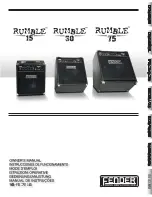
10
3
Insert the string into the hole on the peg and wind
the string onto the peg.
• On the
1st (E) and 2nd
(A) strings
, make two
winds toward the 3rd and 4th string side of the
peg, then wind back over those winds and to
the opposite side of the string hole.
• On the
3rd (D) and 4th (G) strings
, make two
winds toward the 1st and 2nd string side of the
peg, then wind back over those winds and to
the opposite side of the string hole.
Next, make sure that the bridge does not fall over
as you wind the strings. Ensure that the strings
pass over the corresponding slits on the top of
the bridge. (Make sure that the bridge is standing
vertically.)
The 1st string (E) has a protective tube on it. Make
sure the tube is placed on the bridge as shown in
the illustration.
4
Use a piano, tuning fork, tuner, etc., and adjust
the pitch of each string using the tuning pegs.
5
Use the adjuster on the 1st string for fine tuning
of string’s pitch.
3rd string (D)
2nd string (A)
Rotate the
tuning peg
as shown
Rotate the
tuning peg
as shown
1st string (E)
4th string (G)
1st string (E) protective tube.
Adjuster
• When the instrument is not going to be used for an extended period of time, loosen the strings until
the pitch drops a whole tone.
• Do not over-tighten or over-loosen the adjuster. It may result in damage to the
instrument or be a source of noise during performance.
Caution
1st (E) and
2nd
(A) strings
3rd (D) and
4th (G) strings
2-SV200_E/R2
03.8.19, 2:20 PM
10


































